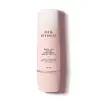What's inside
What's inside
 Key Ingredients
Key Ingredients

 Benefits
Benefits

 Concerns
Concerns

 Ingredients Side-by-side
Ingredients Side-by-side

Water
Skin ConditioningButyl Methoxydibenzoylmethane
UV AbsorberOctocrylene
UV AbsorberTitanium Dioxide
Cosmetic ColorantEthylhexyl Salicylate
UV AbsorberZinc Oxide
Cosmetic ColorantGlycine Soja Phytoplacenta Extract
Skin ConditioningGlycerin
HumectantPhospholipids
Skin ConditioningGlycereth-26
HumectantAluminum Hydroxide
EmollientHydroxyethyl Urea
HumectantNiacinamide
SmoothingRoyal Jelly
Butylene Glycol
Humectant1,2-Hexanediol
Skin ConditioningLecithin
EmollientHydrogenated Lecithin
EmulsifyingDipotassium Glycyrrhizate
HumectantChamaecyparis Obtusa Leaf Extract
Skin ConditioningPotassium Olivoyl PCA
CleansingCeramide NP
Skin ConditioningTromethamine
BufferingGalactoarabinan
Caprylyl Glycol
EmollientHydroxypropyl Cyclodextrin
MaskingMelatonin
AntioxidantAdenosine
Skin ConditioningSodium Hyaluronate
HumectantPhenoxyethanol
PreservativeEthylhexylglycerin
Skin ConditioningWater, Butyl Methoxydibenzoylmethane, Octocrylene, Titanium Dioxide, Ethylhexyl Salicylate, Zinc Oxide, Glycine Soja Phytoplacenta Extract, Glycerin, Phospholipids, Glycereth-26, Aluminum Hydroxide, Hydroxyethyl Urea, Niacinamide, Royal Jelly, Butylene Glycol, 1,2-Hexanediol, Lecithin, Hydrogenated Lecithin, Dipotassium Glycyrrhizate, Chamaecyparis Obtusa Leaf Extract, Potassium Olivoyl PCA, Ceramide NP, Tromethamine, Galactoarabinan, Caprylyl Glycol, Hydroxypropyl Cyclodextrin, Melatonin, Adenosine, Sodium Hyaluronate, Phenoxyethanol, Ethylhexylglycerin
Water
Skin ConditioningOctocrylene
UV AbsorberC12-15 Alkyl Benzoate
AntimicrobialDibutyl Adipate
EmollientPropanediol
SolventBis-Ethylhexyloxyphenol Methoxyphenyl Triazine
Skin ConditioningEthylhexyl Salicylate
UV AbsorberPhenylbenzimidazole Sulfonic Acid
UV AbsorberButyl Methoxydibenzoylmethane
UV AbsorberEthylhexyl Triazone
UV AbsorberAminomethyl Propanol
BufferingMethylheptylglycerin
HumectantCellulose
AbsorbentPhenoxyethanol
PreservativeVp/Acrylates/Lauryl Methacrylate Copolymer
Aloe Barbadensis Leaf Juice Powder
Skin ConditioningAcrylates/C10-30 Alkyl Acrylate Crosspolymer
Emulsion StabilisingXanthan Gum
EmulsifyingDisodium EDTA
Sodium Hyaluronate
HumectantTocopherol
AntioxidantWater, Octocrylene, C12-15 Alkyl Benzoate, Dibutyl Adipate, Propanediol, Bis-Ethylhexyloxyphenol Methoxyphenyl Triazine, Ethylhexyl Salicylate, Phenylbenzimidazole Sulfonic Acid, Butyl Methoxydibenzoylmethane, Ethylhexyl Triazone, Aminomethyl Propanol, Methylheptylglycerin, Cellulose, Phenoxyethanol, Vp/Acrylates/Lauryl Methacrylate Copolymer, Aloe Barbadensis Leaf Juice Powder, Acrylates/C10-30 Alkyl Acrylate Crosspolymer, Xanthan Gum, Disodium EDTA, Sodium Hyaluronate, Tocopherol
Ingredients Explained
These ingredients are found in both products.
Ingredients higher up in an ingredient list are typically present in a larger amount.
Also known as Avobenzone, this ingredient is a chemical sunscreen filter that provides protection in the UV-A range.
Avobenzone is globally approved and is the most commonly used UV-A filter in the world.
Studies have found that avobenzone becomes ineffective when exposed to UV light (it is not photostable; meaning that it breaks down in sunlight). Because of this, formulations that include avobenzone will usually contain stabilizers such as octocrylene.
However, some modern formulations (looking at you, EU!) are able to stabilize avobenzone by coating the molecules.
Avobenzone does not protect against the UV-B range, so it's important to check that the sunscreen you're using contains other UV filters that do!
The highest concentration of avobenzone permitted is 3% in the US, and 5% in the EU.
Learn more about Butyl MethoxydibenzoylmethaneEthylhexyl Salicylate is an organic compound used to block UV rays. It primarily absorbs UVB rays but offers a small amount of UVA protection as well.
Commonly found in sunscreens, Ethylhexyl Salicylate is created from salicylic acid and 2-ethylhexanol. You might know salicylic acid as the effective acne fighter ingredient and BHA.
The ethylhexanol in this ingredient is a fatty alcohol and helps hydrate your skin, similar to oils. It is an emollient, which means it traps moisture into the skin.
According to manufacturers, Ethylhexyl Salicylate absorbs UV wavelength of 295-315 nm, with a peak absorption at 307-310 nm. UVA rays are linked to long term skin damage, such as hyperpigmentation. UVB rays emit more energy and are capable of damaging our DNA. UVB rays cause sunburn.
Learn more about Ethylhexyl SalicylateOctocrylene protects skin from sun damage. It absorbs UV-B with peak absorption of 304 nm. It is a common sunscreen ingredient and often paired with avobenzone, a UVA filter. This is because octocrylene stabilizes other sunscreen ingredients by protecting them from degradation when exposed to sunlight. Octocrylene is a photostable ingredient and loses about 10% of SPF in 95 minutes.
Octocrylene also acts as an emollient, meaning it helps skin retain moisture and softens skin. It is oil-soluble and hydrophobic, enhancing water-resistant properties in a product.
Those who are using ketoprofen, a topical anti-inflammatory drug, may experience an allergic reaction when using octocrylene. It is best to speak with a healthcare professional about using sunscreens with octocrylene.
The EU allows a maximum of these concentrations:
Learn more about OctocrylenePhenoxyethanol is a preservative that has germicide, antimicrobial, and aromatic properties. Studies show that phenoxyethanol can prevent microbial growth. By itself, it has a scent that is similar to that of a rose.
It's often used in formulations along with Caprylyl Glycol to preserve the shelf life of products.
Sodium Hyaluronate is hyaluronic acid's salt form. It is commonly derived from the sodium salt of hyaluronic acid.
Like hyaluronic acid, it is great at holding water and acts as a humectant. This makes it a great skin hydrating ingredient.
Sodium Hyaluronate is naturally occurring in our bodies and is mostly found in eye fluid and joints.
These are some other common types of Hyaluronic Acid:
Learn more about Sodium HyaluronateWater. It's the most common cosmetic ingredient of all. You'll usually see it at the top of ingredient lists, meaning that it makes up the largest part of the product.
So why is it so popular? Water most often acts as a solvent - this means that it helps dissolve other ingredients into the formulation.
You'll also recognize water as that liquid we all need to stay alive. If you see this, drink a glass of water. Stay hydrated!
Learn more about Water